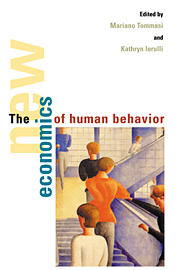Book contents
- Frontmatter
- Contents
- Contributors
- Preface
- Introduction
- PART I DISCRIMINATION AND IMMIGRATION
- PART II CRIME, PUNISHMENT, AND RIGHTS
- PART III ALL IN THE FAMILY
- 5 Human capital, fertility, and economic growth
- 6 Marriage market models
- 7 The marriage premium
- PART IV GOVERNMENT AND POLITICS
- PART V HEALTH, RELIGION, AND MASS BEHAVIOR
- Index
6 - Marriage market models
Published online by Cambridge University Press: 03 December 2009
- Frontmatter
- Contents
- Contributors
- Preface
- Introduction
- PART I DISCRIMINATION AND IMMIGRATION
- PART II CRIME, PUNISHMENT, AND RIGHTS
- PART III ALL IN THE FAMILY
- 5 Human capital, fertility, and economic growth
- 6 Marriage market models
- 7 The marriage premium
- PART IV GOVERNMENT AND POLITICS
- PART V HEALTH, RELIGION, AND MASS BEHAVIOR
- Index
Summary
In 1973, while a first-year graduate student at the University of Chicago, I first became acquainted with Becker's economics of marriage. It was not love at first sight. Some of my fellow students and I thought it was weird to analyze love with economic theories. I still remember how we giggled when we first read a mimeographed version of Becker's theory of marriage prior to its publication. A year later, my attitude started to change. I had become interested in anthropology and had difficulty finding a dissertation topic related to primitive societies. T.W. Schultz — who had been a helpful mentor all along — then offered me access to a perfect data set for an economic analysis of polygamy, a study he was sure Becker would gladly supervise. What started as a hesitating exploration into Becker's controversial theory of marriage soon became the focal point of my career.
Two decades of research later, I realize that Becker's theory of marriage is one of his most important scientific contributions. It has inspired a number of valuable insights and results, some of which are presented in this chapter. In particular, this chapter discusses insights derived from Becker's original theory of marriage regarding the effects of no-fault divorce laws and the effects of marriage market conditions on consumption and labor supply.
- Type
- Chapter
- Information
- The New Economics of Human Behaviour , pp. 92 - 112Publisher: Cambridge University PressPrint publication year: 1995
- 12
- Cited by



